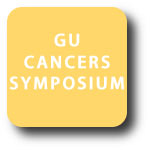ORLANDO, FL, USA (UroToday.com) - In this session Dr. Anthony D’Amico addressed the appropriate duration of androgen deprivation therapy (ADT) use in conjunction with radiation therapy (RT) for localized prostate cancer. He discussed that the difference in appropriate ADT duration was based on disease risk. He presented results from RTOG 9408 which found a 5% survival benefit at 10 years when 4-months of ADT was added to RT for low- and intermediate-risk patients, however the greater benefit was seen in patients with intermediate-risk disease. He discussed that further prospective evidence for the use of ADT in intermediate- and high-risk disease included the TROG 9601 trial performed in Australia and the DFCI 95096 trial from Dana Farber Cancer Institute which demonstrated a 13% survival benefit at 10 years with the use of 6-months of ADT.
 In looking specifically at appropriate duration of ADT in intermediate- and high-risk patients, he focused initially on the RTOG 9910 trial which found no difference in prostate cancer-specific mortality (PCSM) with the use of 4 vs 9 months of ADT in addition to RT for intermediate and high risk. He noted that this study included primarily intermediate-risk patients (84%) and added that the lack of difference seen in PCSM may be the result of the inclusion of a high proportion of patients with favorable intermediate-risk disease. Patients with favorable intermediate-risk disease demonstrated PCSM comparable to low-risk patients even in the absence of the use of ADT, and, thus, in these patients, ADT use may be unnecessary. Patients with unfavorable intermediate-risk disease, in comparison, have been shown to benefit from ADT. Dr. D’Amico showed data which found improved PCSM when ADT was used with brachytherapy when compared to EBRT used with brachytherapy in these patients. He raised the possibility of further risk-stratifying patients with unfavorable intermediate-risk disease by identifying patients with low PSA (< 5) with high volume disease, suggestive of the presence of de-differentiated disease. These patients ultimately demonstrate Gleason upgrading a third of the time. These patients may benefit from even longer courses of ADT with RT.
In looking specifically at appropriate duration of ADT in intermediate- and high-risk patients, he focused initially on the RTOG 9910 trial which found no difference in prostate cancer-specific mortality (PCSM) with the use of 4 vs 9 months of ADT in addition to RT for intermediate and high risk. He noted that this study included primarily intermediate-risk patients (84%) and added that the lack of difference seen in PCSM may be the result of the inclusion of a high proportion of patients with favorable intermediate-risk disease. Patients with favorable intermediate-risk disease demonstrated PCSM comparable to low-risk patients even in the absence of the use of ADT, and, thus, in these patients, ADT use may be unnecessary. Patients with unfavorable intermediate-risk disease, in comparison, have been shown to benefit from ADT. Dr. D’Amico showed data which found improved PCSM when ADT was used with brachytherapy when compared to EBRT used with brachytherapy in these patients. He raised the possibility of further risk-stratifying patients with unfavorable intermediate-risk disease by identifying patients with low PSA (< 5) with high volume disease, suggestive of the presence of de-differentiated disease. These patients ultimately demonstrate Gleason upgrading a third of the time. These patients may benefit from even longer courses of ADT with RT.
Dr. D’Amico then went on examine evidence for ADT duration when used in conjunction with RT for patients with high-risk disease. He stated that the standard of care has been 36 months of ADT for high-risk patients, however given the toxicity associated with long-term ADT, several trials have looked at trying to use shorter durations of ADT. While a trial comparing 36 months to 6 months of ADT in high-risk patients failed to demonstrate non-inferiority, a trial from Canada examining 36 months versus 18 months may ultimately demonstrate non-inferiority of 18 months of ADT. He went on to present the DART study which found an overall survival benefit of 8.7% at 5 years with use of 28 months of ADT when compared to 4 months. He contrasted this to the RTOG 9202 study which found no survival difference when comparing 28 and 4 months of therapy, noting that the patients in the RTOG 9202 study were recruited between 1992 and 1995, and thus likely had a higher proportion of Gleason 9-10 disease in comparison to the DART study and thus had a larger group of patients likely to not respond to ADT. He summarized by saying that currently high-risk patients should receive 28 to 36 months of concurrent ADT with RT, but that in the future, 18 months may prove to be equally efficacious. Patients with a high proportion of Gleason 5 disease, who likely will not benefit from long-term ADT, may benefit from the use of other adjuvant agents like docetaxel or enzalutamide, but further prospective studies will be required to investigate this possibility.
Presented by Anthony V. D’Amico, MD, PhD at the 2015 Genitourinary Cancers Symposium - "Integrating Biology Into Patient-Centric Care" - February 26 - 28, 2015 - Rosen Shingle Creek - Orlando, Florida USA
Brigham and Women’s Hospital, Dana-Farber Cancer Institute, Boston, MA USA
Reported by Timothy Ito, MD, medical writer for UroToday.com


